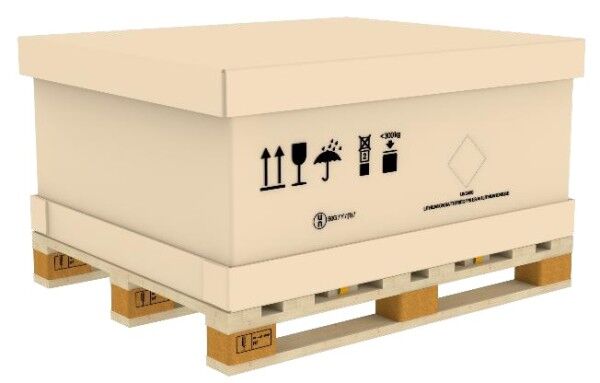incl. VAT.
Please note: Notes on delivery time
Free shipping (Germany, mainland)!
Shippingtime: approx. 1-2 wo.
- Article no: NEFVG21210EC

Questions about the article?
Our staff member Petra Fürbeck is happy to help you:
+49 (0) 7151 - 256 4817 or info@lion-care.com
| Max. Battery size: | 1140 x 960 x 500 mm |
| Empty weight: | 35 kg |
| max. gross mass: | 536 kg |
| max. net dangerous goods mass: | 501 kg |
| Handling the filling material: | without filling material |
| Material name: | Wellpappe |
| Volume: | 501-1000l |
| Packaging group: | Packaging group II |
| Packaging instructions according to ADR: | LP 903, LP 904, LP 905 |
| ADR special provision: | SP 310, SP 376, SP 377 |
| UN packaging code: | UN 50G/Y/MMYR/F/NEFAB/BVT 182856/965/536 |
| Areas of application: | Prototypes, Transport of rechargeable batteries, Automotive, Transportation |
| External dimensions: | 1220 x 1020 x 715 mm |
| Filling material: | without filling material |
| Internal dimensions: | 1144 x 972 x 550 mm |
NEFAB transport packaging is standard packaging for lithium-ion batteries and is specially designed for the safe and efficient transportation of used batteries, urgent shipments, prototypes, batteries for recycling or batteries for second-life applications.
Please note: This is disposable packaging made of corrugated cardboard.
Size and capacity of the battery transport container
The corrugated cardboard transport container has external dimensions of approx. 1220 x 1020 x 715 mm (LxWxH). Inside the box, the dimensions are 1144 x 972 x 550 mm (LxWxH). The usable internal dimensions are approx. 1140 x 960 x 500 mm. When folded, the height is approx. 265 mm. The tare weight of the transport container is approx. 35 kg. The maximum permissible total weight is 536 kg. The base frame can be retracted on 4 sides for industrial trucks. The container can be stacked up to a maximum load of 693 kg static and 536 kg dynamic.
Difference between static and dynamic stacking
With static stacking, goods are stacked on top of each other permanently and unchanged. The arrangement remains constant and there is no movement or reorganization during storage.
With dynamic stacking, on the other hand, the stacked goods are regularly moved, rearranged or removed.
Robust disposable packaging
The box is disposable packaging. The robust corrugated packaging prevents impacts etc.
Use of the NEFAB 1210R transport container
The battery to be packed can be secured using 3 straps. 6 fastening slots are available for this purpose. The battery can be secured with either 25 mm/800 daN or 35 mm/2000 daN straps. These are not included in the box, but can be ordered from the accessories!
Before each use, the integrity of the container and all components must be checked. Only trained and instructed personnel may be entrusted with the installation, storage, relocation and transportation.
Certified for packaging group II
The 1210EC transport container meets the requirements of packaging group II, which means that substances with a high hazard potential may be transported in it. To achieve this classification, the packaging must be type-tested and have withstood a drop height of 1.2 m. All packaging with the code "Y" may be used for packaging groups II (and III).
Suitable for lithium batteries in green and yellow condition --> Accessories are required for "yellow" condition
This transport container can be used for the ADR-compliant transportation of new (green) batteries in accordance with packaging instruction LP 903. An individual inner packaging set for yellow status is required for transporting defective, prototype or end-of-life batteries (yellow). Please contact us if you would like to use the packaging for this! info@lion-care.com , or +49 7151 256 4811 or +49 7151 256 4817.
Suitable for transportation in accordance with SV 376 of the ADR and packaging instruction LP 904
All lithium-ion cells or batteries and lithium-metal cells or batteries that have been damaged and no longer comply with the applicable regulations according to their manual must comply with the provisions of Special Provision 376 (SV 376). This applies, for example, to cells that have leaked or degassed, have suffered external or mechanical damage or have been identified as defective for safety reasons or can no longer be diagnosed prior to transportation.
could. These cells must then be packed in accordance with packing instruction LP 904. According to this directive, for example, it must be ensured that any electrolytes released are absorbed and a non-electrically conductive thermal insulation material must ensure that the environment is protected from dangerous heat development.
Prototype transports according to SV 310 of the ADR and the packaging instruction LP 905
The special provision SV 310 regulates the transportation of prototypes of lithium-ion cells or batteries and lithium-metal cells or batteries. Packing instruction LP 905 then specifies, among other things, requirements for packaging and the mass of dangerous goods.
Transport instructions
All legal regulations as well as any markings and labels must be observed during transportation. All handling operations and transportation of the container must be carried out using suitable and safe means. Before transportation, make sure that the cover is firmly attached to the base frame.
Repair and disposal
Damaged transport containers must not be reused. Repairs may only be carried out by specialists authorized by the manufacturer or by the manufacturer himself. Contaminated components must be disposed of properly in accordance with their contamination.
Certification and guidelines
Lithium batteries fall into dangerous goods class 9. Numerous specifications and guidelines must therefore be observed when transporting lithium batteries.
Future-oriented
Lithium-ion batteries will be indispensable in all industrial applications in the coming years. However, if used improperly, batteries can pose a potential hazard during production, storage and transportation that should not be underestimated. By purchasing these boxes, you protect yourself against major financial losses right from the start.
In use for you
If you have any questions, please do not hesitate to contact us. We look forward to hearing from you!
| Material: | Wellpappe |
| Filling material supplied: | without filling material |
| Coding: | 50G |
| Max. Battery size: | 1140 x 960 x 500 mm |
| Volume: | 610 l |
| Empty weight: | 35 kg |
| max. gross mass: | 536 kg |
| max. net dangerous goods mass: | 501 kg |
| Suitable for critically defective?: | No |
| Type of packaging: | Large hazardous goods packaging (LP) |
| Handling the filling material: | without filling material |
| Material name: | Wellpappe |
| Volume: | 501-1000l |
| Packaging group: | Packaging group II |
| Packaging instructions according to ADR: | LP 903, LP 904, LP 905 |
| ADR special provision: | SP 310, SP 376, SP 377 |
| UN packaging code: | UN 50G/Y/MMYR/F/NEFAB/BVT 182856/965/536 |
| Areas of application: | Prototypes, Transport of rechargeable batteries, Automotive, Transportation |
| External dimensions: | 1220 x 1020 x 715 mm |
| Filling material: | without filling material |
| Internal dimensions: | 1144 x 972 x 550 mm |
That depends on various factors that need to be considered:
- size of the battery(ies)
- condition (e.g. non-critical, defective, critically defective or prototype)
- power
Transport boxes are available in many different sizes and specifications. The packaging group for which the box is suitable is indicated for each product.
Find out more in our blog article:
https://www.lion-care.com/aktuelles/blog/transportvorschriften-regeln-und-sicherheitsmassnahmen
Even if the batteries are not critical, remember to protect them from shocks and to order appropriate filling material if it is not already included in the box.
Yes. Should a battery reach a critical state and cause a fire, separating the batteries will prevent the fire from spreading and multiplying.
Generally, the insulation and protection material should line all sides of the container. The batteries are stored between individual layers.
We also have containers in our program that already have the protective material integrated into the outer wall. No further protective layer is necessary here.
The technical principles for storage and transportation solutions are very similar. The transport boxes are also subjected to extensive tests in accordance with ADR (drop test, fire test, etc.) to confirm compliance with the ADR regulations. The packaging regulations are extensive and regulated by law.
There are currently no comparable regulations for storage. Nevertheless, manufacturers of storage boxes regularly carry out appropriate tests.
The right container depends on the type and size of the battery to be shipped or stored.
If you want to learn more about battery storage and transportation, you will find the answers in our blog articles:
https://www.lion-care.com/aktuelles/blog/transportvorschriften-regeln-und-sicherheitsmassnahmen
https://www.lion-care.com/aktuelles/blog/lithium-ionen-akkus-sicherer-umgang-und-richtige-lagerung
The transportation of batteries is subject to ADR regulations.
The number, size and weight, energy density and condition of the batteries are crucial parameters for finding a suitable transport container for lithium-ion batteries. The selection process is complex and should be carried out by appropriately trained personnel. We have a trained hazardous materials officer on our team. Please feel free to contact us.
Plastic containers are cheaper but not as durable as metal containers. They are suitable, for example, for non-critical batteries, defective batteries, prototypes and end-of-life batteries. They can be used for both storage and transportation.
Metal containers are required, for example, when dealing with critically defective batteries.
The exact packaging instructions for these cases can be found in the ADR or by consulting a certified hazardous materials specialist.
To date, there are no legal requirements for the storage of lithium-ion batteries, which does not mean that they should be stored without suitable protective measures.
It is best to check with your insurer to find out which measures they recognize as suitable in the event of a claim.
For example, a suitable box could already be recognized as spatial separation.
A rough overview can be found in this VDS publication from the GDV:
https://shop. vds.de/download/vds-3103/ccb1d439-ad9d-47cb-a2b1-ace23e155610
Please also read our blog article on this topic:
https://www.lion-care.com/aktuelles/blog/lithium-ionen-akkus-sicherer-umgang-und-richtige-lagerung











